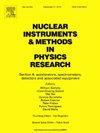Investigation on the temperature characteristics of a laser heating furnace for neutron scattering experiments at CSNS
IF 1.4
3区 物理与天体物理
Q3 INSTRUMENTS & INSTRUMENTATION
Nuclear Instruments & Methods in Physics Research Section A-accelerators Spectrometers Detectors and Associated Equipment
Pub Date : 2025-07-23
DOI:10.1016/j.nima.2025.170900
引用次数: 0
Abstract
Laser heating provides an ideal method for achieving ultra-high temperatures for the samples. The reduced experimental heating times, the increased maximum operation temperature as compared to metal foil furnaces, meet the demands for higher temperature sample environments. Moreover, the achievable rapid temperature changes reduce the ramping times during the experiments, thereby enhancing the utilization rate of neutrons. This paper shows the design of a neutron scattering laser heating system for China Spallation Neutron Source (CSNS) and describes the construction of a laser heating experimental platform based on a general-purpose laboratory furnace. In this study, directional heating experiments on tantalum rods in a vacuum environment were conducted using dual-side fiber lasers in the laser furnace. The dependence relationship between laser power and the maximal temperature ramp rate, the minimal stabilization time and the maximal temperature was studied. Analysis using a finite element model verified by experiments indicates that reducing the laser incidence angle can effectively enhance the uniformity of the temperature field in the sample. This finding provides an important theoretical basis for the optimization of laser heating equipment. The results reveal the intrinsic relationship between laser parameters and sample conditions, offering guidance for the performance optimization of future laser furnaces.
CSNS中子散射实验用激光加热炉温度特性研究
激光加热为实现样品的超高温提供了理想的方法。与金属箔炉相比,减少了实验加热次数,提高了最高工作温度,满足了更高温度样品环境的要求。此外,可以实现的快速温度变化减少了实验过程中的斜坡次数,从而提高了中子的利用率。介绍了中国散裂中子源(CSNS)中子散射激光加热系统的设计,并介绍了基于通用实验炉的激光加热实验平台的搭建。本研究利用激光炉内的双面光纤激光器对钽棒进行了真空环境下的定向加热实验。研究了激光功率与最大温度斜坡速率、最小稳定时间和最高温度的关系。有限元模型分析结果表明,减小激光入射角可以有效提高样品温度场的均匀性。这一发现为激光加热设备的优化提供了重要的理论依据。研究结果揭示了激光参数与样品条件之间的内在关系,为今后激光炉的性能优化提供了指导。
本文章由计算机程序翻译,如有差异,请以英文原文为准。
求助全文
约1分钟内获得全文
求助全文
来源期刊
CiteScore
3.20
自引率
21.40%
发文量
787
审稿时长
1 months
期刊介绍:
Section A of Nuclear Instruments and Methods in Physics Research publishes papers on design, manufacturing and performance of scientific instruments with an emphasis on large scale facilities. This includes the development of particle accelerators, ion sources, beam transport systems and target arrangements as well as the use of secondary phenomena such as synchrotron radiation and free electron lasers. It also includes all types of instrumentation for the detection and spectrometry of radiations from high energy processes and nuclear decays, as well as instrumentation for experiments at nuclear reactors. Specialized electronics for nuclear and other types of spectrometry as well as computerization of measurements and control systems in this area also find their place in the A section.
Theoretical as well as experimental papers are accepted.

 求助内容:
求助内容: 应助结果提醒方式:
应助结果提醒方式:


